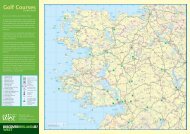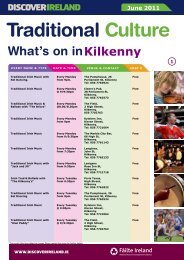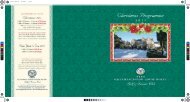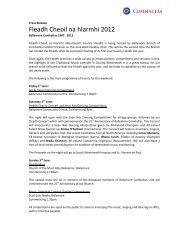Free Guide - Discover Ireland
Free Guide - Discover Ireland
Free Guide - Discover Ireland
You also want an ePaper? Increase the reach of your titles
YUMPU automatically turns print PDFs into web optimized ePapers that Google loves.
Christianity was introduced into <strong>Ireland</strong>, probably from Roman<br />
Britain, during the 5th century AD, around the time of the collapse<br />
of the Roman Empire. Monasterboice is one of <strong>Ireland</strong>’s earliest and<br />
best-known religious sites. Its name derives from the Irish Mainistir<br />
Bhuithe meaning ‘the monastery of Buite’.<br />
St. Buite, Buite mac Bronaig, was an Irish<br />
monk and follower of St. Patrick. In 480,<br />
according to legend, St. Buite on a return<br />
trip from Rome raised Nechtan Morbet,<br />
the King of Pictland (Scotland), from<br />
the dead. Another legend states that he<br />
ascended into heaven via a golden ladder<br />
lowered from the skies by angels. St. Buite<br />
died on the day St. Columba was born (7th<br />
December, 521).<br />
The site comprises two churches and a<br />
round tower. Although round towers were<br />
originally thought to have been places of<br />
refuge from Vikings, the Irish name for<br />
these towers – cloic theach meaning a bell<br />
house – hints at another possible function.<br />
The tower at Monasterboice was burned<br />
in 1097, destroying the monastic library<br />
and other treasures. However, it is still in<br />
excellent condition, though without its<br />
Monasterboice<br />
conical cap. It is the second tallest round<br />
tower in <strong>Ireland</strong>, after the one on Scattery<br />
Island, Co. Clare.<br />
The Vikings occupied the site for a period<br />
until they were routed by Domhnall, King of<br />
Tara, in 968. St. Buite’s monastery remained<br />
an important centre of spirituality and<br />
learning for many centuries until the<br />
establishment of Mellifont Abbey in 1142.<br />
The site also contains two of the finest<br />
High Crosses in <strong>Ireland</strong> – the South Cross<br />
(or Cross of Muiredach) and the West<br />
Cross (or Tall Cross) – which date from the<br />
9th century. The sandstone crosses are<br />
finely carved and depict biblical scenes<br />
from the Old and New Testaments. Today<br />
the image of the High Cross is recognised<br />
internationally, not merely as a religious<br />
icon but also, as a symbol of Irish cultural<br />
heritage.<br />
FOR OPENING TIMES AND ADMISSION DETAILS PLEASE SEE PULL OUT INSERT AT THE BACK 19

















